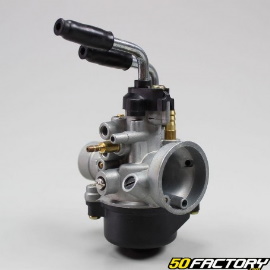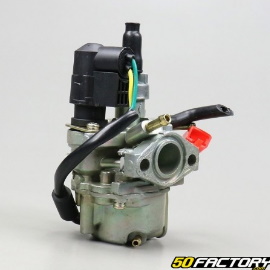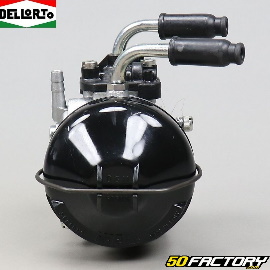Home > general information > Tips and Guides > Technical guides > Generalists >
HOW TO CHOOSE THE RIGHT
HIS CARBURETOR?
The essentials to know before choosing your carburetor:
It is sometimes difficult to know which carburettor to take for this or that configuration. Two types of carburetor: The bushels flat (Keihin type) and round bushels (Dell’Orto type) Flat bushels perform better than round bushels. The flat bushels give more response when opening the throttle. We strongly advise you to disassemble your old carburettor to be sure not to make a mistake when choosing your new model. In most cases, the carburettor type is written on it.
CARBURETORSRS THE MOST FAMOUS
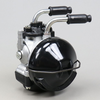
SHA
Displacement 50 to 100 (2) Characteristics Round bushel Ø7 to 15 Separate lubrication No Assembly strict Starter Lever Type of vehicle Scooters and mopeds |
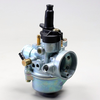
PHVA
Displacement 50 to 100 (2) Characteristics Round bushel Ø10 to 17.5 Separate lubrication Yes Assembly Soft or on bride Starter Automatic or manual Type of vehicle All types |
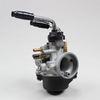
PHBN
Displacement 50 to 100 (2 and 4) Characteristics Round bushel Ø12 to 17.5 Separate lubrication Yes Assembly souple Starter Cable Type of vehicle Scooters and mopeds |
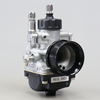
PHBG
Displacement 50 to 100 (2 and 4) Characteristics Round bushel Ø15 to 21 Separate lubrication Depending on model Assembly Soft or rigid Starter Cable Type of vehicle All types |

PHBN
Displacement 125 to 300 (2 and 4) Characteristics Round bushel Ø26 to 30 Separate lubrication Yes Assembly souple Starter Lever or cable Type of vehicle Motorcycles and scooters |
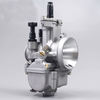
PWK
Displacement 100 to 400 (2 and 4) Characteristics Bushel flat Ø21 to 32 Separate lubrication No Assembly Soft or rigid Starter Lever Type of vehicle Motorcycles and scooters |
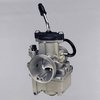
VHST
Displacement 50 to 300 (2 and 4) Characteristics Bushel flat Ø24 to 28 Separate lubrication Depending on model Assembly souple Starter Lever Type of vehicle Motorcycles and scooters |
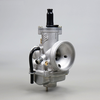
Polini CP
Displacement 2T and 4T Characteristics Bushel flat Ø15 to 24 Separate lubrication Yes Assembly souple Starter Manual (cable or lever) Type of vehicle All types |
Original: the original carburetor fits perfectly; 12 or 16 mm on the Minarelli, and 14 mm on Derbi
With a jar: original or 19 mm
With an engine preparation or an average 50 kit: 19 or 21 mm
With a medium 70 kit (two-segment cast iron, or medium single-segment aluminum): 21 / 24 mm
With very powerful 50 or 70 single-segment aluminum kit: 24 / 28 mm
Anything beyond 28mm is for competition, or fantasy.
For large configurations (type Malossi MHR, Polini Evolution, Hebo Manston Racing, Metrakit ProRace, Barikit factory ...), go straight for a Keihin PWK 28mm carburettor with Powerjet (This is an independent third jet that acts at high rpm. It delivers more fuel at certain valve openings, so you'll get more peak and pick-up).
Le carburettor CP Polini has slightly different dimensions par compared to the most common carburettors. During the purchase, it is therefore necessary to assess the adaptations necessary for its correct assembly.
The carburetor CP Polini is lighter par compared to other commercial carburettors and, under particular conditions, could cause problems with fuel emulsion.
All aluminum, each component has been studied and manufactured in such a way as to aim for the ideal weight/performance ratio. So the carburetor Polini CP overall is 40% lighter than another carburetor with equivalent diameter.
THE DIFFERENCESTS CARBURETORS
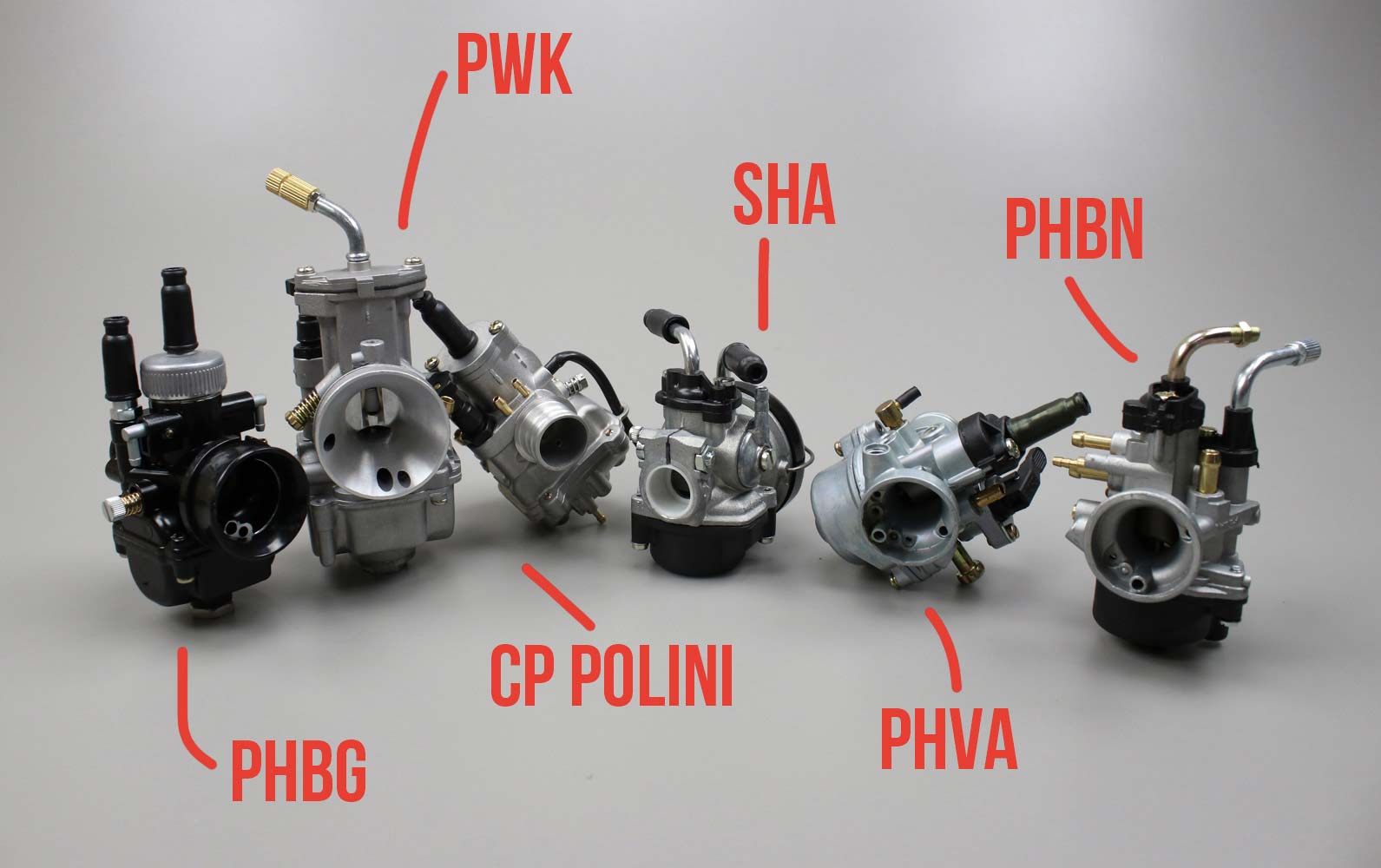
- The SHA carburettors are small in diameter (from 12 to 15mm). You can find them on mobs and also on Aprilia Rs old models, but this type of carburettor is not very widespread nowadays in the world of the mécaboîte.
- The PHVA carburetors et PHBN are 'normal' diameter (14 to 17.5mm), these are the ones found on most 50cm3 in original box and easily recognizable par their 2 screws to disassemble the tank.
- The PHBG carburettors are of ''high'' diameter (from 17.5 to 21mm), easily recognizable with its bowl with 4 screws and its starter push button.
- The PHBH carburetors are large diameter (20 to 30mm), used for large engine setups, they are easily recognizable par their large size (especially in width).
- The VHST carburetors are also large diameter (from 24 to 28mm), often used in medium configurations. They are easily recognizable par their large size and their square tank.
For engines with heavy preparation, we recommend competition type carburettors ( PWK, VHST, etc...) which provide a much better flow of mixture to the motor. Carburetors can have very different shapes and characteristics which directly affect their performance.
Tip: The stock 17.5mm PHVA carburettors aren't worth much performance wise (not much more powerful than a 14 or 16 mm one), so for a real change it's best to fit a 19mm PHBG in place of a 17.5 PHVA if you want a change in performance
SHA and PHBG type carburettors have sprinklers of diameter 5mm, which is not the case for the others...
Be careful when buying a jet to take the one that will suit your carburetor.
CONCLUSION
To choose the right carburetor for your machine, you must take into account the diameter: for Minarelli from 12 to 16 mm PHBN and Polini CP to Derbi 14mm PHVA, PHBG and Polini CP.
The PWK carburettors and Polini CP are very efficient (flat bushels), the PHBG and VH carburettorsST are entry-level carburettors.
EXAMPLES OF COMMON MODELS
The criteria for choosing the carburettor:
- Engine characteristics
- Choice of diameter
- Replacement of the originally defective part or for an increase in performance (be careful, however, some large diameter carburettors are not approved for the road).
The assembly of the carburettor is carried out on a flexible pipe or a rigid pipe.
Carburettors called "separate lubrication" or "lubrication on carburettor" are intended for models which have a small oil inlet on the carburettor (small hose). Models equipped with this type of carburetor are most often 4-strokes. These models have two tanks, one for oil and one for gasoline (mixing is done using a pump usually located in the engine).
CAUTION on some models the small oil inlet hose is connected directly to the intake pipe! In this case, a separately lubricated carb is not necessary.
Carburettors with separate lubrication can just as easily be fitted to models that do not have separate lubrication by obstructing the oil inlet to the carburetor.
In general, models with a vacuum intake on the carburettor do not have a manual fuel tap. Models with an "on/off/reserve" type valve generally do not have a vacuum connection.
The rigid assembly is the assembly where the carburettor is screwed as a female on the pipe male which is generally all aluminum, contrary to the flexible assembly where the pipe is made of rubber and this acts as a female and the carburettor as a male.
There is also the flexible model in aluminum pipe + rubber sleeve.
In general with a soft assembly one can increase the diameter of the carburettor without changing the pipe (up to 21mm but not on all models); on the other hand, the rigid assembly has more constraint car you need a pipe adapted to the carburettor.
Carburetor Principles
The carburettor prepares the mixture of air (combustive) and petrol (fuel).
There is a wide variety of carburettors depending on the use of your two wheels.
When you want to increase the power of an engine at first, the easiest way is to replace the carburetor par a larger model.
The larger the diameter of the carburetor, the greater the fuel consumption, the more efficient the internal cooling.
For a low performance 50cc up to 70cc engine, a 17,5mm model up to 21mm maximum is recommended.
On more powerful 70ccs we recommend 24 to 28mm.
On 80cc ones we recommend from 28 to 32mm and on big 95cc engines or large prep one can go up to 34mm.
The larger the diameter of the carburettor, the greater the surface of the valves will have to be.
It is very important that the rest of theadmission, valve box, intake pipe , etc. be tuned to the diameter of the carburetor, the change of the carburetor imposed the replacement of other ancillary parts.
To help you, here is a formula allowing you to calculate the diameter of the carburettor most appropriate for your engine.
For this calculation, you will need to know the maximum engine speed of your engine, its displacement.
The formula is written like this: D = K x square root of (V x N) / 1000.
D is the diameter of the carburettor (what we are looking for)
K is the level of engine preparation which will be between 0.7 and 0.85 depending on the level of preparation (0.7 being for an original cylinder)
V is the engine displacement which will be expressed here in mm3
et N is the maximum rpm of your engine in rpm.
We therefore obtain this: diameter of the carburettor= level of engine preparation X (square root of (the displacement in mm3 X the maximum speed in rpm)) divided by par 1000 (be careful to respect the parentheses).






